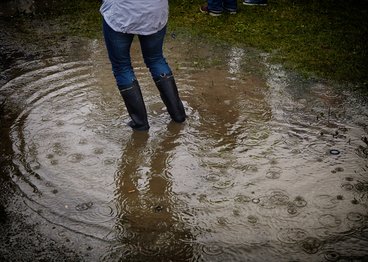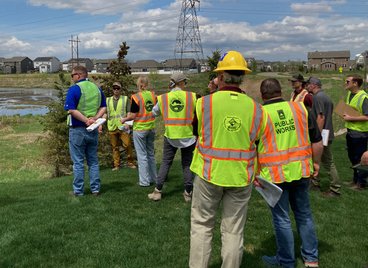Written by Ann Nordby for BBE
Like public health, stormwater management is a practice that's invisible – until it fails. We all rely on a network of stormwater management experts that is below the surface. They keep us healthy and safe from disasters such as flooding, water contamination and fish die-off.

Many of those practitioners received their training at the University of Minnesota's Erosion and Stormwater Management Certification program, a part of the Bioproducts and Biosystems Engineering Department.
The UMN program is nationally recognized as the gold standard. Over the past 20 years, nearly 50,000 people in myriad occupations across the USA and abroad have come to the U to study the practice. Some are city or state planners setting policy for pollutant levels or building practices. Others are chemists with manufacturing plants or construction workers who lay erosion control batting along highways during building projects. Still others are pipeline workers or architects designing large buildings.
They may also be University of Minnesota undergraduates in the BBE program's ecological and environmental engineering specialization. BBE students can take the installer certification as part of the Soil Conservation course. Completing any one of the 12 certificates in stormwater management gives undergraduates a qualification they can add to their resumes. It also helps them to tap into the program's network with government and industry. "We fold it into the course," said Professor John Chapman. "They can put that on their resume and they will easily get a summer internship with a city or watershed district, because they are qualified to inspect for permit compliance."
Chapman is the program director and a researcher focusing on erosion prediction and water quality. The focus is not on storms themselves. "It's not about where the water falls and stands. It's about where our kids swim or the water we drink. All water is connected," Chapman explained.
Pollutants can come from many sources, like construction, fertilizers and chemical spills. Soil itself can be a pollutant if, for example, a large amount of it is washed into a lake during a construction project. Runoff can cause flooding if development is not controlled: building one new house might not be a problem, but replacing a pasture with a whole neighborhood could block rain from soaking into the soil gradually as nature intended.
A rich area for research
Stormwater management also offers interested BBE undergraduates and graduate students some great research opportunities. They tackle questions about erosion and pollutants, and how they affect the ecosystem. What effect does a drought year have on water quality? What types of vegetation are best for shoring up highway roadsides? Has the Emerald Ash Borer affected runoff in certain areas?
Natalie Narvaez (CFANS '23) is finishing up a research project into how far leaf debris travels into sewer systems during storms. It's important, because nutrients such as nitrogen and phosphorus from leaves travel through the stormwater system into lakes, causing nutrification. "If you have too much nutrient loading, you end up with huge growths of algae, which crowds out the natural plants and animals in the water," Narvaez explained. She found that rainwater is not the only way that leaves travel. Winds carry leaves much farther than had been previously thought. "It was really satisfying to do that work - knowing that some leaves come from 200 meters away from the storm drain is useful information," she said. With this knowledge, cities might adjust their street sweeping schedules for the most efficiency.
Narvaez said she learned about the research opportunity in her contaminant hydrology class. She jumped at the chance to work with faculty and to do research. "I wanted to work outside, use my hands, be out in the field," Narvaez said. "I got hooked on it."
History of the program

The certificate program was jointly created by the Minnesota Pollution Control Agency and the Minnesota Department of Transportation, and the University of Minnesota, which manages it independently. Chapman was hired shortly after that. In the 20 years since then, Chapman credits the program's many partners for their foresight and support of Minnesota's water resources. Course fees from participants cover nearly all of the program costs. MnDOT and MPCA continue to be strong partners and champions of clean water in the state. "Partnerships are the key," Chapman said. "I want to emphasize that it's all the different people that are partnering with us: our advisory board has people from agencies, contractors, and industry. I need their opinion to keep improving stormwater management practices and teaching others how to do it well."